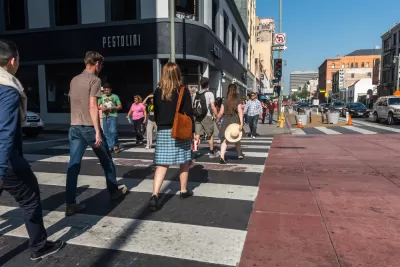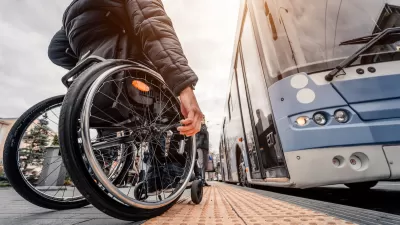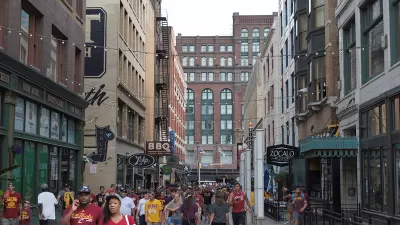Advocates argue that even famously car-centric Los Angeles can become a place where residents can easily access their daily needs without getting behind the wheel.

A coalition of planners, architects, and advocates think Los Angeles—“the ultimate car city”—can become a 15-minute city. That is, with better planning, most residents could reach their daily needs within a 15-minute walking, biking, or public transit trip, reports Erin Stone in LAist.
According to Jenny Hontz of the Livable Communities Initiative, “cars are a culprit when it comes to high rents: cities require developers to build parking spots with housing. In L.A., each spot can cost more than $50,000, upping rent prices.” Consequently, “Higher costs push Angelenos out of the city and into longer commutes, adding to planet-heating emissions. According to 2019 census data, 13% of Angelenos who commuted to the Westside for work drove more than 50 miles to get there.”
The coalition argues that “building smaller housing developments without parking, close to jobs and public transit, coupled with redesigning streets to be more walkable and bikeable, would lower rents and pollution.”
As the article notes, “Implementing the plan doesn't come without obstacles: among other things, it will require rezoning certain areas, dealing with legal challenges and red tape, and dropping the requirement to build parking, in addition to political and industry buy-in.” But with Los Angeles including it in the city’s housing element, it could have legs. Culver City, a small incorporated city on L.A.’s west side, “is on its way to implementing many of the ideas and possibly also working it into their general plan.” Meanwhile, a proposed state bill could eliminate parking requirements for small developments.
FULL STORY: The '15-Minute City': A Strategy To Reduce The Traffic, Pollution And High Housing Costs In LA

Study: Maui’s Plan to Convert Vacation Rentals to Long-Term Housing Could Cause Nearly $1 Billion Economic Loss
The plan would reduce visitor accommodation by 25,% resulting in 1,900 jobs lost.

North Texas Transit Leaders Tout Benefits of TOD for Growing Region
At a summit focused on transit-oriented development, policymakers discussed how North Texas’ expanded light rail system can serve as a tool for economic growth.

Why Should We Subsidize Public Transportation?
Many public transit agencies face financial stress due to rising costs, declining fare revenue, and declining subsidies. Transit advocates must provide a strong business case for increasing public transit funding.

How to Make US Trains Faster
Changes to boarding platforms and a switch to electric trains could improve U.S. passenger rail service without the added cost of high-speed rail.

Columbia’s Revitalized ‘Loop’ Is a Hub for Local Entrepreneurs
A focus on small businesses is helping a commercial corridor in Columbia, Missouri thrive.

Invasive Insect Threatens Minnesota’s Ash Forests
The Emerald Ash Borer is a rapidly spreading invasive pest threatening Minnesota’s ash trees, and homeowners are encouraged to plant diverse replacement species, avoid moving ash firewood, and monitor for signs of infestation.
Urban Design for Planners 1: Software Tools
This six-course series explores essential urban design concepts using open source software and equips planners with the tools they need to participate fully in the urban design process.
Planning for Universal Design
Learn the tools for implementing Universal Design in planning regulations.
City of Santa Clarita
Ascent Environmental
Institute for Housing and Urban Development Studies (IHS)
City of Grandview
Harvard GSD Executive Education
Toledo-Lucas County Plan Commissions
Salt Lake City
NYU Wagner Graduate School of Public Service





























